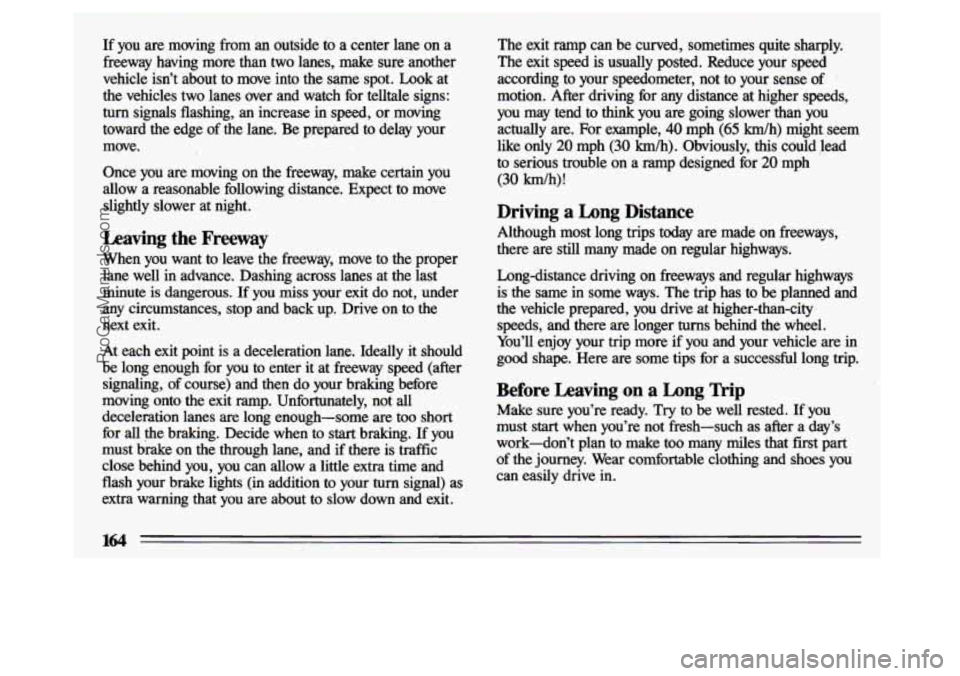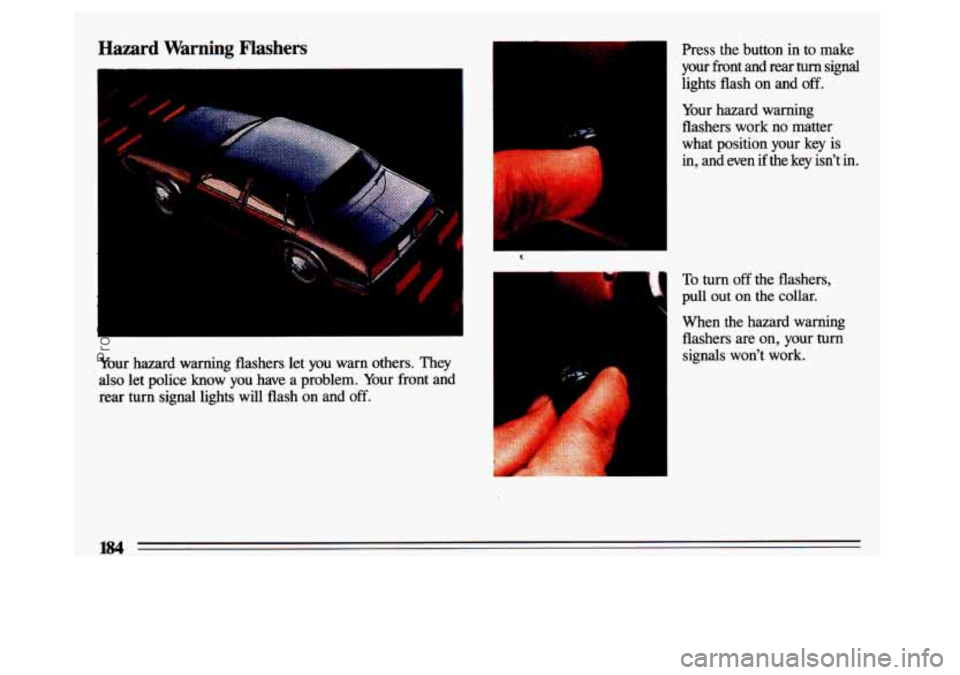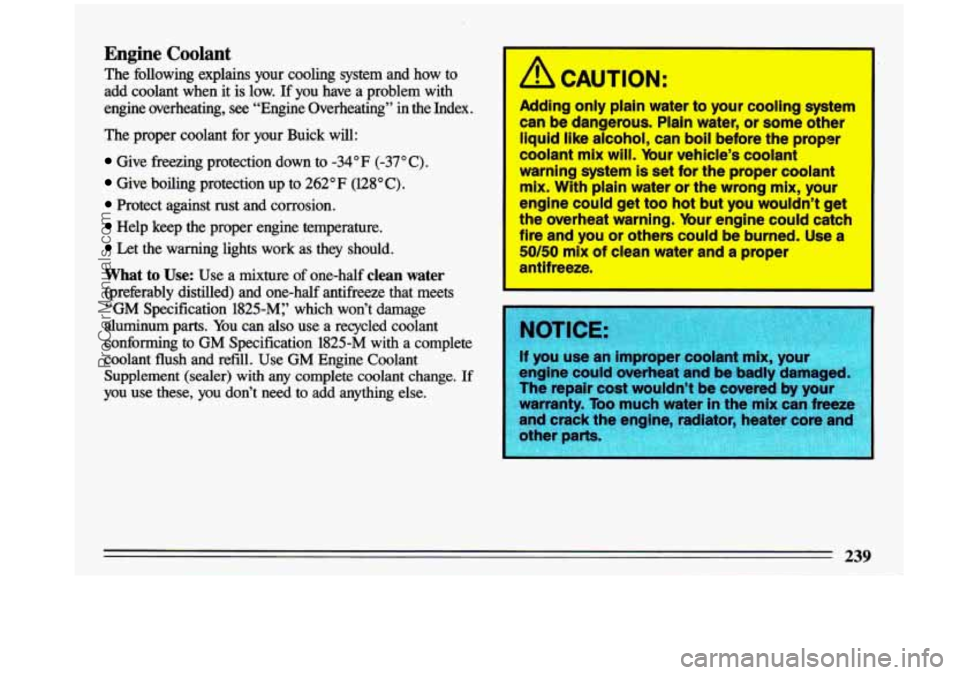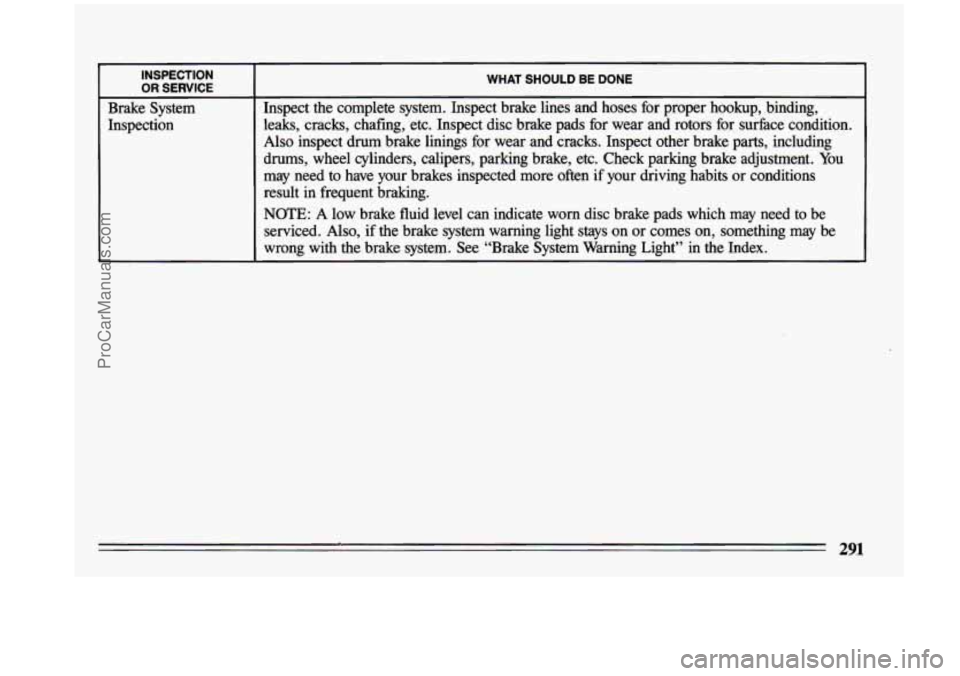1993 BUICK CENTURY warning light
[x] Cancel search: warning lightPage 166 of 324

If you are moving from an outside to a center lane on a
freeway, having more than two lanes, make sure another
vehicle isn’t about
to move into the same spot. Look at
the vehicles two lanes over and watch for telltale signs:
turn signals flashing, an increase in speed, or moving
toward the edge of the lane. Be prepared to delay your
move.
Once you are moving on the freeway, make certain you
allow a reasonable following distance. Expect to move slightly slower at night.
Leaving the Freeway
When you want to-leave the freeway, move to the proper
lane well in advance. Dashing across lanes at the last
minute is dangerous.
If you miss your exit do not, under
any circumstances, stop and back up. Drive
on to the
next exit.
At each exit point is a deceleration lane. Ideally it should
be long enough for you to enter it at freeway speed (after
signaling, of course) and then do your braking before
moving onto the exit ramp. Unfortunately, not all
deceleration lanes are long enough-some are too short
for
all the braking. Decide when to start braking. If you
must bkke on the through lane, and if there is traffic
close behind you, you can allow a little extra time and
flash your brake lights (in addition to your
turn signal) as
extra warning that you are about to slow down and exit. The ,exit ramp can be curved, sometimes quite sharply.
The exit
speed is usually posted. Reduce your speed
according to your speedometer, not to your sense of
motion. After driving for any distance at higher speeds,
you may tend to
think you are going slower than you
actually
are. For example, 40 mph (65 km/h) might. seem
like only
20 mph (30 ludh). Obviously, this could lead
to serious trouble on a ramp designed for
20 mph
(30 ludh)!
Driving a Long Distance
Although most long trips today are made on freeways,
there are still many made on regular highways.
Long-distance driving on freeways and regular highways
is
the same in some ways. The trip has to be planned and
the vehicle prepared, you drive at higher-than-city
speeds, and there are longer turns behind the wheel.
You’ll enjoy your trip more if you and your vehicle are in
good shape. Here are some tips for a successful long trip.
Before Leaving on a Long Trip
Make sure you’re ready. Try to be well rested. If you
must start when you’re not fresh-such as after a day’s
work-don’t plan to make too many miles that first part
of the journey. Wear comfortable clothing and shoes you
can easily drive in.
164
ProCarManuals.com
Page 173 of 324

Winter Driving
Here are some tips for winter driving:
Have your Buick in good shape for winter. Be sure
your engine coolant mix is correct.
Snow tires can help in loose snow, but they may give
you less traction on ice than regular tires. If you do not
expect to
be driving in deep snow, but may have to
travel over ice,
you may not want to switch to snow
tires at all.
vehicle.
You may want to put winter emergency supplies in your
Include an ice scraper, a small brush or broom, a
supply of windshield washer fluid, a rag, some winter
outer clothing, a
small shovel, a flashlight, a red cloth,
and a couple of reflective warning triangles.
And, if
you will
be driving under severe conditions, include a
small bag of sand, a piece of old carpet or a couple of
burlap bags to help provide traction. Be sure you
properly secure these items in your vehicle.
171
ProCarManuals.com
Page 186 of 324

Hazard Warning Flashers
Your hazard warning flashers let you warn others. They
also let police know you have a problem. Your front and
rear turn signal lights will flash on
and off.
Press the button in to make
your front and
rear turn signal
lights flash on and
off.
Your hazard warning flashers work no matter
what position your key is
in, and even if the key isn't in.
To turn off the flashers,
pull out on
the collar.
When the hazard warning flashers are on, your
turn
signals won't work.
ProCarManuals.com
Page 197 of 324

Engine Overheating
You will find a coolant temperature gage or the warning
light about a hot engine on your Buick’s instrument panel. A CAUTION:
Steam from an overheated engine can burn
you badly, even if you
just open the hood. Stay
away from the engine if you see
or hear steam
coming from
it. Just turn it off and get
everyone away from the vehicle until
it cools
down. Wait
until there is no sign of steam or
coolant before opening the hood.
If you keep driving when your engine is
overheated, the liquids
in it can catch fire. You -w others could be badly burned. Stop your
~gine if
it overheats, and get out of the
vehicle until the engine is cool.
195
ProCarManuals.com
Page 241 of 324

Engine Coolant
The following explains your cooling system and how to
add coolant when it is low.
If you have a problem with
engine overheating, see “Engine Overheating” in the Index. \
The proper coolant for your Buick will:
Give freezing protection down to -34°F (-37°C).
Give boiling protection up to 262” F (128” C).
Protect against rust and corrosion.
Help keep the proper engine temperature.
Let the warning lights work as they should.
What to Use: Use a mixture of one-half clean water
(preferably distilled) and one-half antifreeze that meets
“GM Specification 1825-Mi’ which won’t damage
aluminum parts. You can also use a recycled coolant
conforming to GM Specification 1825-M with a complete
coolant flush
and refill. Use GM Engine Coolant
Supplement
(sealer) with any complete coolant change. If
you use these, you don’t need to add anything else.
I
A CAUTION:
Adding only plain water to your coollng system
can
be dangerous. Plain water, or some other
liquid
like alcohol, can boil before the proper
coolant mix will. Mur vehicle’s coolant
warning system
Is set for the proper coolant
mix. With plain water or the wrong mlx, your
engine could get too hot but you wouldn’t get
the overheat warning. bur engine could catch
fire and you or others’could be burned. Use a
50/50 mPx of clean water and a proper
antifreeze.
I
: warranty. Too much
l
and crack t
other parts
239
ProCarManuals.com
Page 245 of 324

Brake Master Cylinder
I
Your brake master cylinder is here. It is filled with
DOT-3 brake fluid.
There are only two reasons why the brake fluid level in
your master cylinder might go down. The first is that
the
brake fluid goes down to an acceptable level during normal brake lining wear. When new linings are put in,
the fluid level goes back
up.
The other reason is that fluid is leaking out of the brake
system.
If it is, you should have your brake system fixed,
since a leak means that sooner
or later your brakes won’t
work well, or won’t work at all.
So, it isn’t a good idea to “top off’ your brake fluid.
Adding brake fluid won’t correct a leak. If you add fluid
when your linings are worn, then you’ll have too much
fluid when you get new brake linings.
You should add (01
remove) brake fluid, as necessary, only when work is
done on the brake hydraulic system.
A CAUTION:
If you have too much brake fluid, it can spill on
the engine. The fluid
will burn if the engine is
hot enough. Mu or others could be burned,
and your vehicle could
be damaged. Add
brake fluid only when work is done on the
brake hydraulic system.
When your brake fluid falls to a low level, your brake
warning light will come on. See “Brake System Warning
Light” in the Index.
What to Add:
When you do need brake fluid, use only DOT-3 brake
fluid-such as Delco Supreme
ll@ (GM Part No.
1052535). Use new brake fluid from a sealed container
only.
ProCarManuals.com
Page 269 of 324

Fuse Usage
I
I
Fuse Rating
(AMPS)
A
B
C
D E
15
20
10
10
15
ECM; MAF Sensor (3300 Engine only)
ECM Injectors/Coil
Eng. A/C Relay; EGR Solenoid; Canister Purge Solenoid
Fan/Elect; Generator; DRL Module
Turn Signal Flasher; Back-up Lights;
TruWLiftgate Release
Fuse
F
G
H
I
J
K
L
M
Rating
(AMPS)
10
20
20
10
20
20
30"
5
Circuitry N
0
P
Q
10
30"
25
20
15
15
15
Circuitry
Supplemental Inflatable Restraint (Air Bagj
Tail; Park; Side Marker; License Plate; Stop/Turn Signal
Heater/Air Conditioner
Gages; Warning Indicators; Torque Convert
Clutch; Audible Warning System; Computer Command Control; Trunk Release; Brake
Warning Indicator; Rear Defog Switch;
Speedometer
Stop Lights; Hazard Flashers
Interior, Underhood, Courtesy, I/P, Trunk Lights; Door
Locks; Horn Relay, Passive Restraint
System, Deck Lid Release, Power Antenna
Liftgate Release; Power Windows
Illumination for: I/P, Radio,
Pod Lights,
Ashtray, Console Light, Heater-A/C Control,
Defog Switch, Headlight Switch
Radio, Cruise Control
Seats, Door
Locks, Rear Defog
Windshield Wipe/Wash
Cigarette Lighter
Safety Belt/Chirne (ICAM) Module (Located
behind the fuse block, above the hush panel.)
Remote Lock Control (Located behind the fuse
block, above the hush panel.) Fuel Pump, ECM (Located under the hood.)
*Circuit Breaker
267
ProCarManuals.com
Page 293 of 324

~ ~~ ~ ~ ~~~ INSPECTION
OR SERVICE
Brake System
Inspection
WHAT SHOULD BE DONE
Inspect the complete system. Inspect brake lines and hoses for \
proper hookup, binding,
leaks, cracks, chafing, etc. Inspect disc brake pads for wear \
and rotors for surface condition.
Also inspect drum brake linings for wear and cracks. Inspect o\
ther brake parts, including
drums,
wheel cylinders, calipers, parking brake, etc. Check parking bra\
ke adjustment. You
may need to have your brakes inspected more often
if your driving habits or conditions
result
in frequent braking.
NOTE: A low brake fluid level can indicate worn disc brake pads which may need to be
serviced.
Also, if the brake system warning light stays on or comes on, something may be
wrong with the brake system. See “Brake System Warning Light\
” in the Index.
ProCarManuals.com